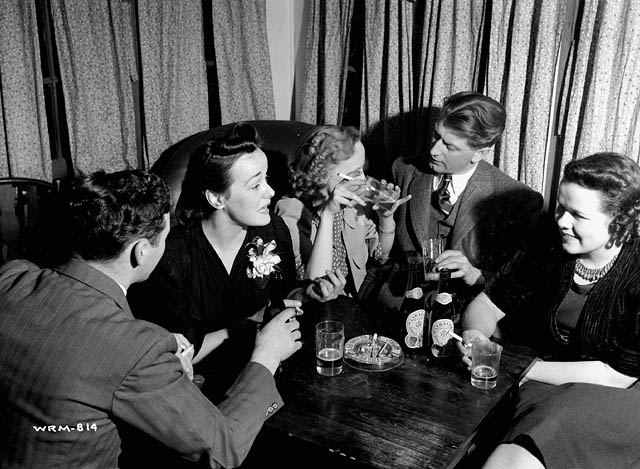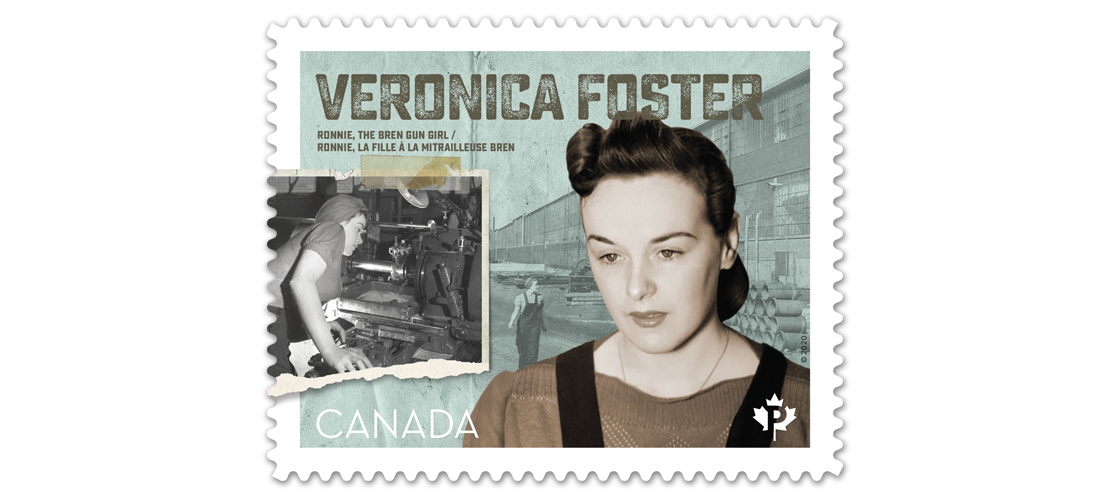Veronica Foster Guerrette, Second World War icon, model, vocalist (born 2 January 1922 in Montreal, Quebec; died 4 May 2000 in Toronto, Ontario). Foster worked for the John Inglis Company assembling Bren light machine guns during the Second World War. She was featured on propaganda posters that encouraged women to serve Canada by working in munitions factories. Foster became a Canadian icon representing female workers in the manufacturing industry. After the war, she was lead singer with the dance band Mart Kenney and His Western Gentlemen.

Early Life and Education
Veronica Foster was born in Montreal, Quebec, on 2 January 1922. Her parents were Daniel Leo Foster and Catherine Frances Empey Foster. Foster was the fifth of eight siblings. She had four brothers and three sisters. Foster moved with her mother and siblings to the Christie Pits area in Toronto, Ontario. As a teenager, she lived in both Montreal and Toronto.
Women Workers in the Second World War
During the Second World War (1939–45), Veronica Foster joined many Canadian women who entered the paid workforce in record numbers. During the war, thousands of Canadian men left their jobs to join the armed forces. Women like Foster filled the empty spaces in munitions factories and other industries. Women also entered agriculture, textile and service industries in record numbers. Some women, like aeronautical engineer Elsie Gregory MacGill, took jobs previously reserved for men. MacGill managed all engineering work for the Hurricane and Helldiver fighter planes. (See also Canadian Women and War.)
More commonly, women worked on the assembly lines in factories. Veronica Foster worked on the assembly line at the John Inglis Company on Strachan Avenue in Toronto. (The John Inglis Company was later acquired by Whirlpool.) There, Foster assembled Bren light machine guns used by British and Canadian soldiers.
The Bren Gun Girl
The Canadian government actively recruited female workers during the Second World War to help manage labour shortages across the country. In 1941, the National Film Board (NFB) was named official photographer for the government. The NFB’s still photography department searched for a Canadian woman they could feature on recruitment posters. They chose 19-year-old Foster.
The NFB used Foster’s image in a publicity campaign to recruit more women into factory work. In 1941, the NFB took a series of photos at the John Inglis Company featuring Foster. Foster became known as “Ronnie the Bren Gun Girl.” In one photograph from 1941, she wears a headscarf and smokes a cigarette while gazing down at a Bren light machine gun. Other photos of Foster include her dancing at the Glen Eagle Country Club, playing baseball, and wearing a glamorous hat and fur coat. In addition to showing Foster hard at work, the National Film Board intended to show her being active and having fun in her leisure hours. “Ronnie the Bren Gun Girl” was a persona created to show the public that a female factory worker could also be glamorous and feminine. Although depicted smoking a cigarette in her most famous photo, Foster did not actually smoke. Foster’s image was used to glamorize war-related industrial work in the early years of the Second World War.

Foster’s whole family worked hard to contribute to the war effort. While she worked at the John Inglis factory, three of her brothers enlisted to fight in the war. Foster represented patriotic ideals to the Canadian public, encouraging others to fulfill their patriotic duty by entering the workforce. Foster’s image captured the imagination of the public, and she became popular among Canadians.
Inspired by the success of the National Film Board’s campaign, the United States of America created a fictional American woman for their own propaganda posters. Foster thus directly inspired the famous American propaganda symbol “Rosie the Riveter.” Like Ronnie, Rosie wore a headscarf and displayed a tough, energetic, yet feminine image.
Later during the Second World War, recruitment posters changed their focus. As labour shortages continued, the Canadian government began to target married women with children as potential factory workers. While Foster’s 1941 photos depicted freedom and adventure, later recruitment campaigns highlighted female workers who blended domesticity, piety, and family life. (See also Propaganda in Canada.)

After the War
After the Second World War, Veronica Foster left her job at the John Inglis Company. She worked as a model and performed with big bands as a singer. She frequently performed at the Old Mill Inn in Toronto. She also performed with the Trump Davidson Orchestra.
Foster was the lead singer with the dance band Mart Kenney and His Western Gentlemen, which was popular across Canada.
While singing with the Mart Kenney band, Foster met trombone player George Guerrette. Guerrette was also a composer and a conductor. Foster and Guerrette married in 1945 and had five children. Their son George also went on to become a professional musician and composer.
In 1948, the family moved to Edmundston, New Brunswick. There George Guerrette worked as the general manager of the local radio station. After her husband died in 1963, Foster briefly moved to Montreal to work as a sales manager for CP Hotels. She then moved to Toronto with her five children. While living in Toronto, Foster became a successful real estate agent, winning awards in her field. She also volunteered as the coordinator of the Metropolitan Symphonic Band.

Later Life and Legacy
Veronica Foster’s diverse interests included golf and charcoal drawing. She died on 4 May 2000 in Toronto, Ontario.
In 2016, a travelling exhibit by the National Film Board included Second World War photographs of Foster. “The Other NFB” exhibit was designed to teach the public about the little-known still photography division (1941–84).
In May 2020, Canada Post released two stamps to mark the 75th anniversary of the V-E Day (Victory in Europe). One highlighted Private Léo Major while the other featured Veronica Foster.

 Share on Facebook
Share on Facebook Share on X
Share on X Share by Email
Share by Email Share on Google Classroom
Share on Google Classroom


